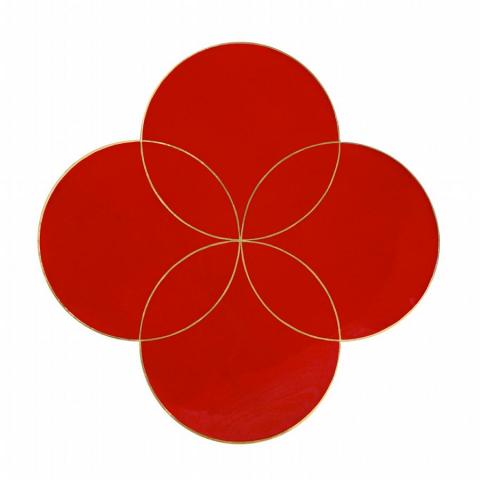SKY GATE, 2003
Max Gimblett
(60” QUATREFOIL)
gesso, polyurethane and acrylic polymer on wood panel
152.5 x 152.5 cm (irregular)
signed and dated verso: MAX GIMBLETT 2003
Gow Langsford Gallery, Auckland
Private collection, Sydney
Max Gimblett left New Zealand more than forty years ago and settled in New York City. It began a career which saw him exhibit and be collected in the United States, East Asia, Europe and Australia and New Zealand. He maintains strong links with New Zealand and he is now regarded as one of its most distinguished senior artists. The wellspring of his ideas and influences come from Eastern philosophies - especially Zen. Recognizing the importance of Gimblett's enduring interest in Eastern thought, the Solomon R Guggenheim Museum included him in its major 2009 exhibition, The Third Mind, American Artists Contemplate Asia 1860-1989.1 He was represented with a large quatrefoil painting - and these are the works by which the artist is best known.
The quatrefoil - its idiosyncratic shape - was first used by Gimblett in the early eighties. And when we think of the history of painting it's not something we associate with the West. For Gimblett it is a form which represents part of the symbolism contained within the work itself. And Gimblett's use of materials; of paints, resins and precious metals hold a connection with their symbolic applications in particular cultures. Stylistically the quatrefoils have ranged from immediate calligraphic gestures which come out of an enduring respect for the work of Gibbon Sengai2 to cooler, more restrained and subtle surfaces in which the clarity of form and pure application of materials consume the work with a contemplative elegance.
In Sky Gate, 2003, we see a work of austere and sublime beauty. A work which personifies Gimblett's idea of the transformation of colour, symbols and shapes into his unique expression.
It also alludes to his earlier works from when he first arrived in New York City. Geos - as the artist likes to call them. Where colour and one or two simple bars or circles marked his work as part of America's preoccupation with formalist abstraction. Yet for Gimblett the spiritual depth of what colour might represent was already taking shape and Buddha 1977 is an example of this.3
Sky Gate represents the brilliant synthesis of Gimblett's vast aesthetic, stylistic and philosophical interests which have marked him not only as one of New Zealand's finest 20th-century painters, but also an artist who has secured an international reputation.
1. The Third Mind, American Artists Contemplate Asia 1860-1989, Solomon R Guggenheim Museum, New York, 30 January - 19 April 2009.
2. Gibbon Sengai (Japan 1750-1837); Zen artist.
3. Buddha 1977; acrylic polymer on canvas; 178.0 x152.5; San Francisco Museum of Modern Art; Gift of Don Grisanti.
DOUG HALL AM
